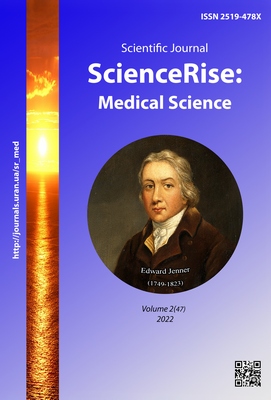Structural changes of brain vessels in cardiosurgery patients with postoperative stroke
DOI:
https://doi.org/10.15587/2519-4798.2022.256461Keywords:
brain, blood vessels, structural changes, thrombosis, embolism, cardiac surgery, strokeAbstract
Hypoxic-ischemic lesions of the brain of cardiac surgery patients as a leading factor in stroke have been studied. The importance of prolonged thrombosis, embolism, which exacerbate the general degenerative changes in the central nervous system is recognized.
The aim of the research – to study the morphological changes of the vessels of the brain of cardiac surgery patients with postoperative stroke on the background of hypoxic-ischemic complications.
Materials and methods. Pieces of cerebral vessels were subjected to microscopic examination. Histological sections were stained according to Van Gieson.
Results and their discussion. The study of the structure of the vessels of the brain of persons who were in the group intact to neurological pathology control, showed the presence of anatomical and functional changes that are fully consistent with the sex-age norms of postnatal human ontogenesis.
The drugs of the clinical observation group contained signs of pathological changes characteristic of hypoxic-ischemic disorders. It is obvious that their appearance and intensification contributed to the development of ischemic stroke. Structural and functional changes mainly concerned the vascular walls, their layers, paravasal spaces, the blood system as a liquid phase, in fact. Endothelial layer with signs of desquamation. Endothelial cells are characterized by signs of hyperchromia of the nuclei, the shift of the latter in the direction of one of the poles of the cells, the appearance of heterochromatin. Contacts between cells are weakened, defects are visible in the surface layer. Perovascular edema, which is formed in the case of increased permeability, leads to a certain isolation of individual vessels from the surrounding tissues, followed by the development of hypoxia. Defects of the wall layers lead to the activation of the migratory properties of platelets, encourage the appearance of megakaryocytes, erythrocyte thrombi, which are in close contact with the endothelial layer of blood vessels. On histological specimens, brick-red blood clots abundantly cover the damaged inner layer of vascular walls, sometimes completely filling their openings. Over time, defects in the layers of the walls are accompanied by thrombosis, inflammation, edema.
Conclusions. Hypoxic-ischemic brain lesions in cardiac surgery patients play a leading role in stroke. Priority is given to hypoxia, which contributes to ischemia, trophic disorders, atrophy, necrosis, necrobiotic changes. The latter are the organic basis of pathogenetic patterns of focal cerebral infarction (with progressive destruction of brain cells, its vessels, the development of prolonged thrombosis, embolism, increased general degenerative changes in the central nervous system)
References
- Feigin, V. L., Roth, G. A., Naghavi, M., Parmar, P., Krishnamurthi, R., Chugh, S. et. al. (2016). Global burden of stroke and risk factors in 188 countries, during 1990–2013: a systematic analysis for the Global Burden of Disease Study 2013. The Lancet Neurology, 15 (9), 913–924. doi: http://doi.org/10.1016/s1474-4422(16)30073-4
- Costa, M. A. C. da, Gauer, M. F., Gomes, R. Z., Schafranski, M. D. (2015). Risk factors for perioperative ischemic stroke in cardiac surgery. Revista Brasileira de Cirurgia Cardiovascular, 30 (3), 365–372. doi: http://doi.org/10.5935/1678-9741.20150032
- Demikhov, O., Dehtyarova, I., Rud, O., Khotyeev, Y., Kuts, L., Cherkashyna, L. et. al. (2020). Arterial hypertension prevention as an actual medical and social problem. Bangladesh Journal of Medical Science, 19 (4), 722–729. doi: http://doi.org/10.3329/bjms.v19i4.46632
- Torianyk, I. I., Kolesnyk, V. V. (2014). Morpfologichniy dysayn ishemichnogo insultu. Visnyk morfologii, 2, 37–42.
- Mankovsky, D. S. (2021). Tserebralnyi krovoobih ta faktory ryzyku formuvannia hipoksychno-ishemichnykh urazhen holovnoho mozku u kardiokhirurhichnykh patsiientiv pry vykorystanni shtuchnoho krovoobihu. Vitchyzniana nauka – perspektyvy ta innovatsii. Kyiv: «Kyivskyi medychnyi naukovyi tsentr», 22–26.
- Todurov B.M., Kuzmych I.M., Tarabrin O.O. (2015). Porushennia funktsii tsentralnoi nervovoi systemy pislia operatsii zi shtuchnym krovoobihom u patsiientiv z nyzkoiu fraktsiieiu vykydu livoho shlunochka. Clinical Anesthesiology and Intensive Care, 2, 82–90.
- Rubinshteyn, S. (2019). Osnovy obschey psikhologii. Saint-Petersburg: Piter, 720.
- An, N., Yu, W.-F. (2017). Difficulties in Understanding Postoperative Cognitive Dysfunction. Journal of Anesthesia and Perioperative Medicine, 4, 87–94. doi: http://doi.org/10.24015/japm.2017.0010
- Spoelstra, S. L., Schueller, M., Hilton, M., Ridenour, K. (2014). Interventions combining motivational interviewing and cognitive behaviour to promote medication adherence: a literature review. Journal of Clinical Nursing, 24 (9-10), 1163–1173. doi: http://doi.org/10.1111/jocn.12738
- Johnson, W., Onuma, O., Owolabi, M., Sachdev, S. (2016). Stroke: a global response is needed. Bulletin of the World Health Organization, 94 (9), 634–634A. doi: http://doi.org/10.2471/blt.16.181636
- O’Neal, J. B., Billings, F. T., Liu, X., Shotwell, M. S., Liang, Y., Shah, A. S. et. al. (2017). Risk factors for delirium after cardiac surgery: a historical cohort study outlining the influence of cardiopulmonary bypass. Canadian Journal of Anesthesia/Journal Canadien D’anesthésie, 64 (11), 1129–1137. doi: http://doi.org/10.1007/s12630-017-0938-5
Downloads
Published
How to Cite
Issue
Section
License
Copyright (c) 2022 Dmytro Mankovskyi

This work is licensed under a Creative Commons Attribution 4.0 International License.
Our journal abides by the Creative Commons CC BY copyright rights and permissions for open access journals.
Authors, who are published in this journal, agree to the following conditions:
1. The authors reserve the right to authorship of the work and pass the first publication right of this work to the journal under the terms of a Creative Commons CC BY, which allows others to freely distribute the published research with the obligatory reference to the authors of the original work and the first publication of the work in this journal.
2. The authors have the right to conclude separate supplement agreements that relate to non-exclusive work distribution in the form in which it has been published by the journal (for example, to upload the work to the online storage of the journal or publish it as part of a monograph), provided that the reference to the first publication of the work in this journal is included.









